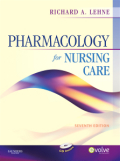
This text emphasizes understanding over memorization to effectively present the "big picture" through the use of drug prototypes, large and small print, and special foundational chapters that cover principles related to each body system. At the end of each chapter, a summary of major nursing implications also helps you apply the material to real-world situations. The accompanying companion CD-ROM features audio and printable key points that you can download to a CD or MP3 player. The CD-ROM also features 700 NCLEX® examination-style multiple-choice review questions, animations depicting drug mechanisms and effects, flash cards, and numerous electronic calculators. INDICE: I. INTRODUCTION1. Orientation to Pharmacology2. Application of Pharmacology in Nursing Practice3. Drug Regulation, Development, Names, and InformationII. BASIC PRINCIPLES OF PHARMACOLOGY4. Pharmacokinetics5. Pharmacodynamics6. Drug Interactions7. Adverse Drug Reactions and Medication Errors8. Individual Variation in Drug ResponsesIII. DRUG THERAPY ACROSS THE LIFESPAN9. Drug Therapy During Pregnancy and Breast-Feeding10. Drug Therapy in Pediatric Patients11. Drug Therapy in Geriatric PatientsIV. PERIPHERAL NERVOUS SYSTEM DRUGSIntroduction12. Basic Principles of Neuropharmacology13. Physiology of the Peripheral Nervous SystemCholinergic Drugs14. Muscarinic Agonists and Antagonists15.Cholinesterase Inhibitors and Their Use in Myasthenia Gravis16. Drugs That Block Nicotinic Cholinergic Transmission: Neuromuscular Blocking Agents and Ganglionic Blocking AgentsAdrenergic Drugs17. Adrenergic Agonists18. Adrenergic Antagonists19. Indirect-Acting Antiadrenergic AgentsV. CENTRAL NERVOUS SYSTEM DRUGSIntroduction20. Introduction to Central Nervous System PharmacologyDrugs for Neurodegenerative Disorders21. Drugs for Parkinson's Disease22. Alzheimer's Disease23. Drugs for Multiple SclerosisNeurologic Drugs24. Drugs for Epilepsy25. Drugs for Muscle Spasm and SpasticityDrugs for Pain26. Local Anesthetics27.General Anesthetics28. Opioid (Narcotic) Analgesics, Opioid Antagonists, and Nonopioid Centrally Acting Analgesics29. Pain Management in Patients with Cancer30. Drugs for HeadachePsychotherapeutic Drugs31. Antipsychotic Agents and Their Use in Schizophrenia32. Antidepressants33. Drugs for Bipolar Disorder34. Sedative-Hypnotic Drugs35. Management of Anxiety Disorders36. Central Nervous System Stimulants and Attention-Deficit/Hyperactivity Disorder Drug Abuse37. Drug Abuse I: Basic Considerations38. Drug Abuse II: Alcohol39. Drug Abuse III: Major Drugs of Abuse (Other Than Alcohol) VI. DRUGS THAT AFFECT FLUID AND ELECTROLYTE BALANCE40. Diuretics41. Agents Affecting the Volume and Ion Content ofBody FluidsVII. DRUGS THAT AFFECT THE HEART, BLOOD VESSELS, AND BLOOD42. Review of Hemodynamics43. Drugs Acting on the Renin-Angiotensin-Aldosterone System44. Calcium Channel Blockers45. Vasodilators46. Drugs for Hypertension47. Drugs for Heart Failure48. Antidysrhythmic Drugs49. Prophylaxis of Coronary Heart Disease: Drugs Lower that LDL Cholesterol Levels50. Drugs for Angina Pectoris51. Anticoagulant, Antiplatelet, and Thrombolytic Drugs52. Management of ST-Elevation Myocardial Infarction53. Drugs for Hemophilia54. Drugs for Deficiency Anemias55. Hematopoietic Growth FactorsVIII. DRUGS FOR ENDOCRINE DISORDERS56. Drugs for Diabetes Mellitus57. Drugs for Thyroid Disorders58. Drugs Related to Hypothalamic and Pituitary Function59. Drugs for Disorders of the Adrenal CortexIX. WOMEN'S HEALTH60. Estrogens and Progestins: Basic Pharmacology and Noncontraceptive Applications61. Birth Control62. Drug Therapy of Infertility63. Drugs that Affect Uterine FunctionX. MEN'S HEALTH64. Androgens65. Drugs for Erectile Dysfunction and Benign Prostatic HyperplasiaXI. ANTI-INFLAMMATORY, ANTIALLERGIC, AND IMMUNOLOGIC DRUGS66. Review of the Immune System67. Pediatric Immunization68. Immunosuppressants 69. Antihistamines70. Cyclooxygenase Inhibitors: Nonsteroidal Anti-inflammatory Drugs and Acetaminophen71. Glucocorticoids inNonendocrine DiseasesXII. DRUGS FOR BONE AND JOINT DISORDERS72. Drug Therapy of Rheumatoid Arthritis 73. Drug Therapy of Gout74. Drugs Affecting Calcium Levels and Bone MineralizationXIII. RESPIRATORY TRACT DRUGS75. Drugs for Asthma76. Drugs for Allergic Rhinitis, Cough, and ColdsXIV. GASTROINTESTINAL DRUGS77.Drugs for Peptic Ulcer Disease78. Laxatives79. Other Gastrointestinal DrugsXV. NUTRITION80. Vitamins81. Drugs for ObesityXVI. CHEMOTHERAPY OF INFECTIOUS DISEASES82. Basic Principles of Antimicrobial Therapy83. Drugs That Weaken the Bacterial Cell Wall I: Penicillins84. Drugs That Weaken the Bacterial Cell WallII: Cephalosporins, Carbapenems, Vancomycin, Aztreonam, Teicoplanin and Fosfomycin85. Bacteriostatic Inhibitors of Protein Synthesis: Tetracyclines, Macrolides, and Others86. Aminoglycosides: Bactericidal Inhibitors of Protein Synthesis87. Sulfonamides and Trimethoprim88. Drugs Therapy of Urinary Tract Infections89. Antimycobacterial Agents: Drugs for Tuberculosis, Leprosy, and Mycobacterium avium Complex Infection90. Miscellaneous Antibacterial Drugs: Fluoroquinolones, Metronidazole, Daptomycin, Rifampin, Bacitracin, and Polymyxins91. Antifungal Agents92. Antiviral Agents I: Drugs for Non-HIV Viral Infections93. Antiviral Agents II: Drugs for HIV Infection and Related Opportunistic Infections94. Drug Therapy of Sexually Transmitted Diseases95. Antiseptics and DisinfectantsXVII. CHEMOTHERAPY OF PARASITIC DISEASES96. Anthelmintics97. Antiprotozoal Drugs I: Antimalarial Agents98. Antiprotozoal Drugs II: Miscellaneous Agents99. EctoparasiticidesXVIII. CANCER CHEMOTHERAPY100. Basic Principles of CancerChemotherapy101. Anticancer Drugs I: Cytotoxic Agents102. Anticancer Drugs II: Hormonal Agents, Biologic Response Modifiers, and Targeted DrugsXIX. ADDITIONAL IMPORTANT DRUGS103. Drugs for the Eye104. Drugs for the Skin105. Drugs forthe Ear106. Miscellaneous Noteworthy DrugsXX. ALTERNATIVE THERAPY107. Herbal SupplementsXXI. TOXICOLOGY108. Management of Poisoning109. Potential Weapons of Biologic, Radiologic, and Chemical TerrorismAPPENDIXESA. Adult ImmunizationB. Guide to Gender-Related DrugsC. Pronunciation of Generic Drug NamesD. Weights and MeasuresE. Normal Laboratory ValuesF. Commonly Used AbbreviationsG. Techniques of Drug AdministrationH. Canadian Drug InformationI. Major Drug Classesand Their PrototypesJ. Very New Drugs and Important New Formulations of OlderDrugs
- ISBN: 978-1-4160-6249-3
- Editorial: Saunders
- Encuadernacion: Rústica
- Páginas: 1376
- Fecha Publicación: 14/09/2009
- Nº Volúmenes: 1
- Idioma: Inglés
